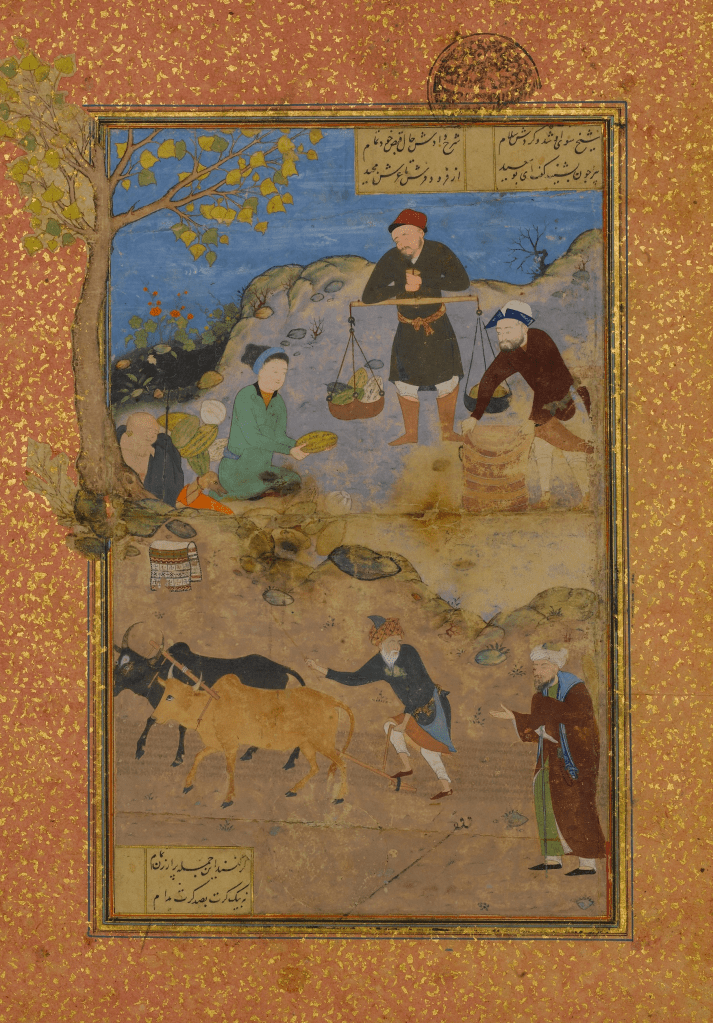
The hagiography of the Anatolian Muslim saint Ḥācım Sulṭān (first introduced here) captures various snapshots of a major transitional period in the region’s history, in which over the course of the fifteenth and early sixteenth century the frontier polities that had proliferated in the post-Mongol period were being incorporated into the rapidly expanding Ottoman Empire. Ottoman expansion took place in a world in which nomadic and semi-nomadic Turkic-speakers had spread widely in Anatolia and further west into the Balkans, part of a general cultural and social flux marked by the disappearance of the Byzantine Empire and an increasingly complex and diverse articulation of Islam in town and countryside. Given that Ḥācım Sulṭān’s hagiography dates from somewhere in the fifteenth century- almost certainly after the incorporation of Germiyan, the polity in which much of the action occurs, into the Ottoman realm- we can usefully read it as a window into some of the realities and cultural attitudes typical of the start of the Ottoman period. The Ottoman polity itself is not mentioned, nor is any other higher-level polity. Instead, authority operates at the very local level, invested in strongmen in towns, in town and village qāḍīs- such as the one in the following story- and in the sometimes competing, sometimes cooperating saintly dervishes wandering the countryside or dwelling in saints’ shrines.
The story excerpted and translated here is set in a village, to which the saint has come for a time (the central story arc of the first third or so of the hagiography is Ḥācım Sulṭān’s quest for the designated place of his future āstāne and shrine). He tends, with the helps of his miraculous black bull companion, the village herds, occupying a rather ambiguous position: he is referred to here and at other points in the story as being a ‘dīvāne,’ a polyvalent word literally meaning ‘crazy’ but also connotative of a wandering dervish. The characters in this story use it in a decidedly negative way, pointing to a reality that Ḥācım Sulṭān’s hagiography does not try to obscure: not everyone accepted his sainthood, and the towns and countryside of earliest modern Anatolia had many claimants to sanctity, not all of whom received universal acclaim. It is also worth noting that here and in many other stories in this vilāyetnāme women feature prominently, both as supporters of the saint and as members of a sometimes skeptical audience in need of convincing.
Finally, alongside depictions of everyday life in the countryside- putting cattle out to pasture, the threat of wolves, and the like- we also see a local qāḍī, or judge, at work. The question of who appointed him and from whence he draws his salary is of no interest to our narrative; what counts is his responsiveness to the villagers’ request for an investigation and his willingness to accept Ḥācım Sulṭān’s proofs of sainthood. Already in this period we get the sense that the norms of Islamic jurisprudence were known to some degree even deep in the countryside, an important foundation for the effectiveness of the Ottoman scholarly-legal bureaucracy and hierarchy already being formed.

Another vilāyet of Ḥācım Sulṭān: there was a little elderly woman who had a single cow (ınek). She would bring the cow out to pasture. Then one day Sulṭān Ḥācım said to her, ‘Mother, by God’s command a wolf is going to eat this cow! Do not pasture her.’ But the woman did not listen. She put the cow out to pasture. Now [Ḥācım Sulṭān] gathered all the cattle [of the village] gathered together and moved them along, but this poor woman’s cow separated from the rest of the cattle and went to another place. With God’s permission a wolf came forth and ate the cow up. Evening fell. All of the animals returned to their homes, but the woman’s cow did not come. For a while they searched but did not find [it]. Finally, the woman’s sons were at a loss. Then about it they said, ‘That crazy one (dīvāne) has palmed off this cow! At any rate let’s go and find him.’ So they went and asked Ḥācım Sulṭān, ‘What did you do with our cow?’ He replied, ‘Your cow was eaten by a wolf in such-and-such a place in the vicinity of such-and-such.’ To which they replied, ‘Surely you are talking nonsense! Come, let us go to the qāḍī and you give [him] answer.’ Ḥācım Sulṭān replied, ‘Let us go!’
So from there they went to the qāḍī. The sons complained to the qāḍī, saying, ‘Efendi, this crazy one watched over our cattle—or, rather, he himself didn’t, his big black bull did. Now, ask this careless one what he did with our cow!’ So the qāḍī asked, ‘Crazy one, what did you do with these young men’s cow? Let us see how things stand.’ Ḥācım Sulṭān replied, ‘I warned this aged mother that she ought not put the cow out to pasture as with God’s permission as a wolf would eat [it]. She did not listen, added [the cow] to the grazing herd, and the wolf ate [it].’ Continue reading “The Cow, the Wolf, and the Talking Rocks”
